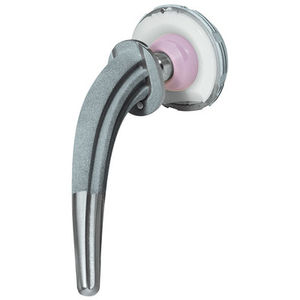
Revision femoral stem SP IIcemented or non-cementedrightleft

Add to favorites
Compare this product
Characteristics
- Surgical application
- revision
- Fixation type
- cemented or non-cemented
- Side
- right, left
- Femoral stem length
130 mm, 150 mm, 170 mm
(5.12 in, 5.91 in, 6.69 in)- Femoral stem offset
35 mm, 37 mm, 40 mm, 46 mm, 49 mm
(1.38 in, 1.46 in, 1.57 in, 1.81 in, 1.93 in)- CCD angle
117 °, 126 °, 135 °
Description
The design is adapted to the anatomical shape of the femur
Successfully used for 40 years
Proven by a wealth of clinical data.
Minimal occurrence of periprosthetic fractures
Minimally invasive implantation
Neutralizes torsional forces:
The curved shape of the stem enables it to finds its way into the femoral canal, where it adapts perfectly to the anatomy.6 This means that stress peaks, as occur with three-point locking of straight shafts, are avoided and the stem has greater rotational stability.
Available with a modular prosthesis head since 1984, this femoral stem was a great success and had a major influence on the principle of the anatomical hip prosthesis.1 The S‑shaped curvature, which follows the natural anatomy of the femur, has proved highly successful in this system. This has been repeatedly confirmed over the last 40 years in numerous publications, including the Swedish Hip Arthroplasty Register.1, 3 The outstanding clinical history was the reason for developing the ribbed prosthesis, the C.F.P. stem, and the SP-CL, based on the same principle.
Anatomical design:
The anatomical shape of the stem enables it to fit centrally in the medullary canal. This helps to ensure a uniform cement coating, which can envelop the implant optimally.7 At the same time, anteroposterior and mediolateral ribs contribute to rotational stability.
Optimal anatomical reconstruction:
The SP II offers a system with great modularity. The multiplicity of possible variations in CCD angle, neck length, and stem length gives maximum flexibility for reconstruction of the anatomical structures in primary and revision arthroplasties.
VIDEO
Related Searches
- Orthopedic surgery surgery set
- Arthrodesis nail
- Femoral stem
- Knee prosthesis
- Femoral intramedullary nail
- Acetabular prosthesis
- Cementless femoral stem
- Press-fit acetabular prosthesis
- Hip prosthesis
- Tibial intramedullary nail
- Cemented femoral stem
- Fixed-bearing knee prosthesis
- Right intramedullary nail
- Left intramedullary nail
- Revision femoral stem
- Primary hip prosthesis
- Revision knee prosthesis
- Mobile-bearing knee prosthesis
- Press-fit hip prosthesis
- Cemented knee prosthesis
*Prices are pre-tax. They exclude delivery charges and customs duties and do not include additional charges for installation or activation options. Prices are indicative only and may vary by country, with changes to the cost of raw materials and exchange rates.

























